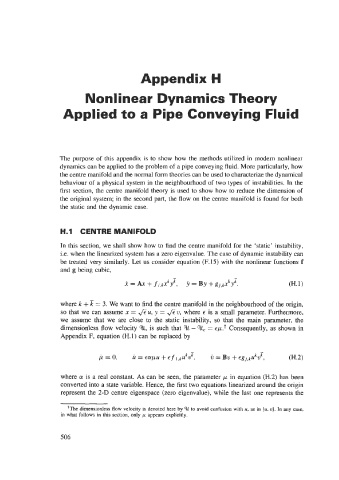Page 536 - Fluid-Structure Interactions Slender Structure and Axial Flow (Volume 1)
P. 536
Appendix H
Nonlinear Dynamics Theory
Applied to a Pipe Conveying Fluid
The purpose of this appendix is to show how the methods utilized in modem nonlinear
dynamics can be applied to the problem of a pipe conveying fluid. More particularly, how
the centre manifold and the normal form theories can be used to characterize the dynamical
behaviour of a physical system in the neighbourhood of two types of instabilities. In the
first section, the centre manifold theory is used to show how to reduce the dimension of
the original system; in the second part, the flow on the centre manifold is found for both
the static and the dynamic case.
H.1 CENTRE MANIFOLD
In this section, we shall show how to find the centre manifold for the ‘static’ instability,
Le. when the linearized system has a zero eigenvalue. The case of dynamic instability can
be treated very similarly. Let us consider equation (F.15) with the nonlinear functions f
and g being cubic,
kk
X = AX + f i,kXkyk, j’ = By + gj,kx y . (H. 1)
where k + k = 3. We want to find the centre manifold in the neighbourhood of the origin,
so that we can assume x = &u, y = &u, where E is a small parameter. Furthermore,
we assume that we are close to the static instability, so that the main parameter, the
dimensionless flow velocity Q, is such that % - Qc = ep.+ Consequently, as shown in
Appendix F, equation (H.l) can be replaced by
where (Y is a real constant. As can be seen, the parameter p in equation (H.2) has been
converted into a state variable. Hence, the first two equations linearized around the origin
represent the 2-D centre eigenspace (zero eigenvalue), while the last one represents the
+The dimensionless flow velocity is denoted here by OU. to avoid confusion with u, as in [u. v). In any case,
in what follows in this section, only fi appears explicitly.
506

